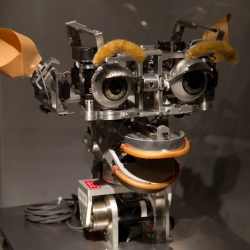
Today, large suppliers and their large customers dominate industrial robotics. But almost any manufacturer can afford a Baxter (or two). In the United States alone, there are roughly 300 000 small and medium-size manufacturers, Brooks points out. So it’s not inconceivable that Rethink could make humanoid robots a normal part of the manufacturing process for businesses of all sizes. And by improving the efficiency of human employees, it could make making things in the industrialized world just as cost effective as making them in the developing world.
Baxter is unlike any other industrial robot. With two arms, each with seven axes of motion—or degrees of freedom, in robotic parlance—and a reach similar to that of a human, Baxter is designed to take over those simple, dumb, mindless tasks that humans hate to perform because they’re so, well, robotic. Whereas traditional industrial robots perform one specific task with superhuman speed and precision, Baxter is neither particularly fast nor particularly precise. But it excels at just about any job that involves picking stuff up and putting it down somewhere else while simultaneously adapting to changes in its environment, like a misplaced part or a conveyor belt that suddenly changes speed.
There are two other major barriers to the adoption of industrial robots that Rethink wants to overcome: ease of use and cost. As for the first, Baxter doesn’t rely on custom programming to perform new tasks. Once it’s wheeled into place and plugged into an ordinary power outlet, a person with no robotics experience can program a new task simply by moving Baxter’s arms around and following prompts on its user-friendly interface (which doubles as the robot’s face). And while a traditional two-armed robot, including sensors and programming, will typically set you back hundreds of thousands of dollars, Baxter costs just $22 000. To achieve that, Rethink designed the robot from scratch. Underneath Baxter’s plastic exterior lie thousands of ingeniously engineered parts and materials that enable the robot to do what it does for the cost of a midsize car.
